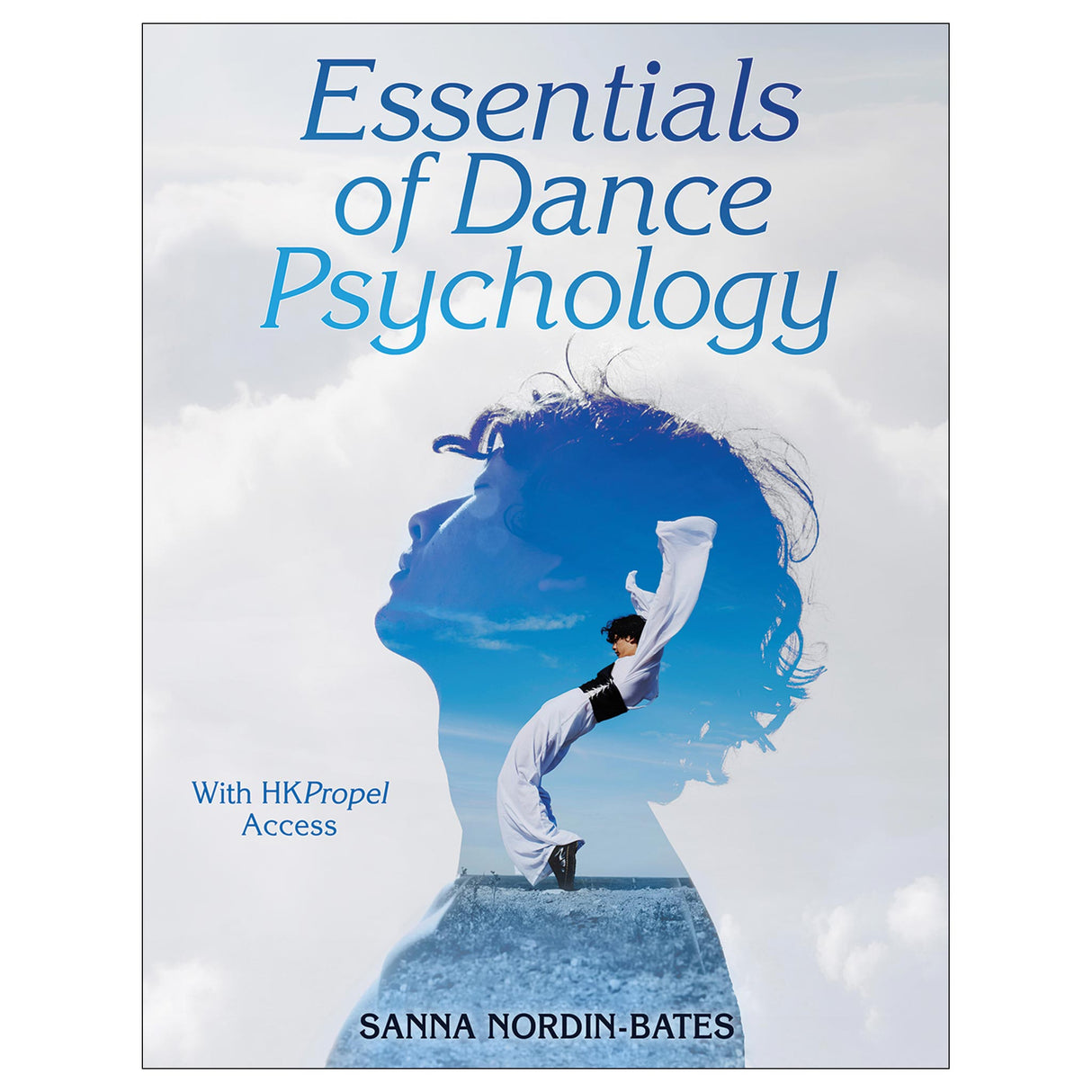Essentials of Dance Psychology Ebook With HKPropel Access
Author: Sanna Nordin-Bates
$72.00 USD

Through Essentials of Dance Psychology, readers will come to understand why dancers think and behave as they do and how to design healthy, creative dance environments that lead to both well-being and optimal performance.
The book is built on a foundation of evidence from dance and sport psychology research, with applied experiences used as examples throughout. Where appropriate, evidence from other areas of psychology—for example, cognitive behavioral therapy—is used. A thorough coverage of topics relevant to dancers, teachers, and others working to support dancers is included, making the book suitable for one slightly longer course or two short courses in introductory dance psychology.
The book is organized into four parts. Part I delves into dancers’ individual differences, examining how personality, perfectionism, self-esteem, self-confidence, and anxiety factor into performance and well-being. Part II explores topics related to dance-specific characteristics such as motivation, attentional focus, and creativity. In part III, readers learn about a range of psychological skills, including mindfulness, goal setting, self-regulation, and imagery. Part IV examines topics related to dance environments and challenges, zeroing in on the social aspects of teaching and learning dance, the challenges of talent identification and development, injuries, body image, and disordered eating.
Student-friendly textbook features in each chapter include the following:
- Relevant definitions
- A case study that shows how the chapter’s topics can be expressed or experienced in practice
- One or more Get Practical exercises, which prompt readers to apply or reflect on the chapter’s concepts (These exercises come with either downloadable worksheets or audio, delivered through HKPropel Access.)
- A roundup of further research needed in each content area, which can inspire research projects for students and professionals alike
- Key points to reinforce the learning, with particular emphasis on applications
Essentials of Dance Psychology offers readers the opportunity to understand sport psychology from the vantage point of a dancer. The text will help develop dance teachers who are able to inspire and sustain high levels of performance and psychological health among dancers. It will also help other professionals who work with dancers to implement evidence-based practices that enhance and sustain dancers’ lives and careers.
Note: A code for accessing HKPropel is included with this ebook.
Audience
Textbook for undergraduate- and graduate-level courses in dance science, dance wellness, and dance pedagogy for dance teacher training. Professional reference for dance instructors in academic settings, private studios, therapists, and dance companies.What Is Dance Psychology?
Cognitive Behavioral Therapy in Dance Psychology
Part I. Individual Differences
Chapter 1. Personality
What Is Personality?
Structure of Personality
Origins of Personality
Consequences of Personality
Narrow Identity: Are Dancers at Risk?
Chapter 2. Perfectionism
What Is Perfectionism?
Origins of Perfectionism in Dance
Consequences of Perfectionism
How Can Perfectionism Be Managed?
Chapter 3. Self-Esteem and Self-Confidence
What Are Self-Esteem and Self-Confidence?
Origins of Self-Esteem
Consequences of Self-Esteem
Origins of Self-Confidence
Consequences of Self-Confidence
How Can Self-Esteem and Self-Confidence Be Strengthened?
Chapter 4. Anxiety
What Is Anxiety?
Sources of Anxiety
Consequences of Anxiety
How Can Anxiety Be Managed?
Part II. Dance-Specific Characteristics and Dispositions
Chapter 5. Motivation
What Is Motivation?
Achievement Goal Theory Perspective on Motivation
Self-Determination Theory Perspective on Motivation
How Can Healthy Motivation Be Nurtured? An Intrapersonal Perspective
Chapter 6. Attentional Focus
What Is Attentional Focus?
Performance-Related Consequences of Different Attentional Foci
Attentional Focus Research in Dance
Why Attentional Focus Has an Impact
How Can Optimal Attentional Focus Be Nurtured?
Chapter 7. Creativity
What Is Creativity?
Sources of Creativity
Correlates of Creativity
How Can Creativity Be Nurtured?
Part III. Psychological Skills
Chapter 8. Mindfulness
What Is Mindfulness?
Origins of Mindfulness
Consequences of Mindfulness
Mindfulness Research in Dance
Why Mindfulness Has an Impact
How Can Mindfulness Be Nurtured?
Chapter 9. Goal Setting and Self-Regulation
What Is Goal Setting?
Sources of Goals: Assigned Goals Versus Personal Values
Consequences of Goal Setting
Why Goal Setting Has an Impact
What Is Self-Regulation?
How Can Goal Setting and Self-Regulation Be Optimized?
Chapter 10. Imagery
What Is Imagery?
Revised Applied Model of Deliberate Imagery Use
Sources of Imagery
Consequences of Imagery
Why Imagery Has an Impact
How Can Imagery Be Optimized?
Part IV. Dance Environments and Challenges
Chapter 11. Motivational Climates
What Is a Motivational Climate?
Achievement Goal Theory (AGT) Perspective: Task- and Ego-Involving Climates
Self-Determination Theory Perspective: Need-Supportive Versus Controlling Leadership
Origins of Motivational Climates: What Makes Teachers Support or Thwart Healthy Motivation?
Consequences of Motivational Climates
How Are Healthy Motivational Climates Created?
Chapter 12. Talent
What Is Talent?
Sources of Talent
Consequences of Talent Beliefs and of Talent Identification
How Can Talent Identification and Development Be Optimized?
Chapter 13. Injury
What Are the Key Psychological Aspects of Injury in Dance?
Psychological Risk Factors for Acute Injury: Stress-Injury Model
Beyond the Stress-Injury Model: Other Psychological Risk Factors for Dance Injury
Dancers’ Experiences of Becoming and of Being Injured
Psychological Aspects of Injury Rehabilitation
Using Psychology to Reduce Injury Risk and Optimize Rehabilitation
Chapter 14. Body Image and Disordered Eating
What Is Body Image?
Eating Disorders Versus Disordered Eating
Origins of Negative Body Image and Disordered Eating in Dance
Consequences of Body Image and Disordered Eating
How Can Healthy Body Image Be Nurtured?
How Can Disordered Eating Be Prevented, Identified, and Managed?
How Can Healthy Motivation Be Nurtured? An Intrapersonal Perspective
Performance-Related Consequences of Achievement Goals
Setting SMART GOALS
All ancillaries are free to adopting instructors through HKPropel.
Instructor guide. Includes a sample course syllabus as well as chapter summaries, activities, essay topics, websites, and teaching tips.
Test package. Contains 249 questions in true-false, fill-in-the-blank, essay and short-answer, and multiple-choice formats. The files may be downloaded for integration with a learning management system or printed for use as paper-based tests.
Presentation package. Features more than 400 PowerPoint slides of text, artwork, and tables from the book that can be used for class discussion and presentation. The slides in the presentation package can be used directly within PowerPoint or printed to make handouts for students. Instructors can easily add, modify, and rearrange the order of the slides.
Instructors also receive access to all student materials in HKPropel. For Essentials of Dance Psychology, this includes forms and audio (where applicable) for each chapter’s Get Practical exercises, key term flash cards, lettering art, and two goal-setting templates.





